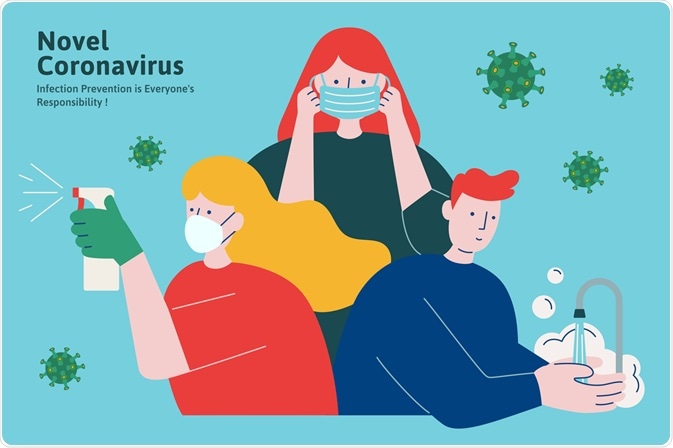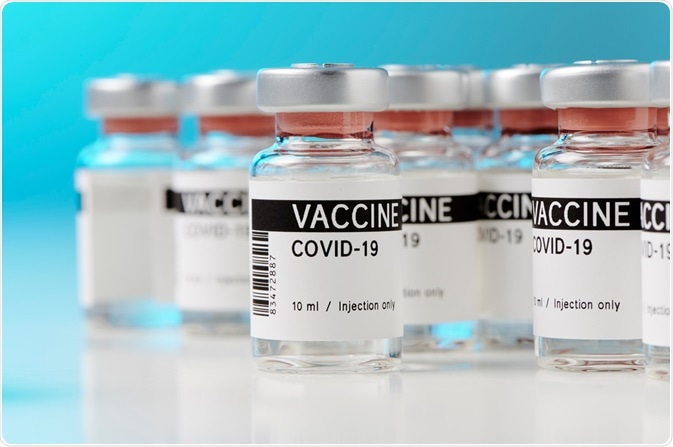The coronavirus disease 2019 (COVID-19) pandemic has been devastating in its impact. The chances are that its toll was needlessly high due to a parallel pandemic of misinformation that swept hundreds of thousands of people away from safety-driven measures into potentially harmful practices and behaviors.
This article deals with some of the leading myths floating around, while not offering an exhaustive debunking of each. The point is that a little research and the ability to evaluate what one hears, reads, or experiences critically goes a long way in discerning truth, and helping to protect oneself, one’s family, and one’s community from unnecessary disease or even death, apart from financial and social distress.
In order to sift incoming information for truth, it is necessary to look at the source, explore the supporting information, and check the credentials of the person saying it for scientific credibility, neutrality, and access to current research.

Image Credit: MITstudio/Shutterstock.com
Risk factors
One persistent red herring has been the misconception that the introduction of 5G mobile technology is responsible for the pandemic. The rumor belies the obvious fact that COVID-19 is spreading in many regions without such technology, and therefore does not spread via radio waves.
Another popular myth is that only the old, sick, and unfit get COVID-19. While these are certainly at a higher risk of infection, and severe disease, younger people can be infected, become sick, and even die.
Children can get COVID-19 too, and may develop severe or life-threatening complications such as multisystem inflammatory syndrome in children (MIS-C). Since most children are not currently vaccinated against the virus, the number of cases in this population is increasing. Mask used in public and hand hygiene, as well as staying home when one is sick, will help protect children and those around them.
Drugs, disinfectants, and supplements
Alcohol-based sanitizers do not cause antibiotic resistance, since pathogens do not become resistant to them. Nor do they typically cause skin rashes, bleaching, or irritation, though rare incidents have been reported.
The use of these sanitizers does not introduce alcohol into the body but instead improves health by helping to eliminate the virus from the hands, making them compatible with most faiths. Using a common dispenser doesn’t put you at higher risk of getting the virus, because the sanitization occurs AFTER touching the bottle.
Medications such as hydroxychloroquine and ivermectin have been touted as effective preventatives and therapeutic agents against SARS-CoV-2. At present, it may be safely said that, when used off-label against COVID-19, at the doses currently used, they are not toxic.
However, no trial has yet shown benefit in terms of reduced rates of illness, hospitalization, or death from COVID-19 from the use of these drugs. Evidence is still awaited in this area.
Vitamin D toxicity is possible at doses not far above those commonly used to treat or prevent COVID-19, especially if vitamin D is used for a long time. While adequate levels of vitamin D, ascorbic acid, and zinc are required for robust immune function, they have not been shown to combat COVID-19 specifically.
Quercetin and essential oils are also not known to be protective or of therapeutic value in this condition. Silver, marketed in colloidal form as a treatment for the infection, is not known to be either safe or effective.
Flu and pneumococcal vaccines do not prevent COVID-19, but by helping reduce the incidence of these potentially deadly illnesses, they can bring down the overall mortality during this pandemic period.
Using an alcohol- or chlorine-based spray over the body is potentially toxic to the eyes, mouth, or clothes. Bleach and other disinfectants are highly toxic, and should not be used to disinfect the skin, nor should they EVER be ingested.
Vaccines
Herd immunity will not be achieved by letting the infection spread take its natural course because too many people will die or be permanently disabled by the severe complications of COVID-19.
Vaccinations are being rolled out at top speed, to protect those at risk of severe infection by surrounding them with a wall of healthy people with robust protective immunity against the virus. This immunity also eliminates the virus from the body such that mutations do not occur and persist, giving rise to new variants of the virus.
This being so, the rumor that the vaccines are creating new variants is implausible. In fact, many variants arose long before the first vaccine emerged on the scene.
The vaccines cannot give the virus to the vaccinated individual or anyone else, because they do not contain the live virus. Symptoms such as headache, fever, joint pains, and muscle pains indicate an inflammatory immune reaction, as with most vaccines, rather than being signs of COVID-19 itself.
The unprecedented speed at which the COVID-19 vaccines were developed, and the use of novel platforms, does not mean that corners were cut. Rather, the researchers leveraged decades of experimental work with these vaccine platforms as well as the earlier work on vaccines against the previous pathogenic coronaviruses, SARS-CoV, and the Middle East Respiratory Syndrome coronavirus (MERS-CoV).
Some allege that more people have died of COVID-19 vaccination than of the virus. Not only is this not true, but the data on the Vaccine Adverse Event Reporting System (VAERS) is not directly related to vaccine-related deaths. This is because: 1) anyone can report any event following vaccination to the system, irrespective of whether it was even remotely related to the vaccine. 2) Some VAERS data is incomplete, cannot be verified, wrong, or results from a coincidence.
Recently, the number of deaths reported to VAERS following COVID-19 vaccination has been misinterpreted and misreported as if this number means deaths that were proven to be caused by vaccination. Reports of adverse events to VAERS following vaccination, including deaths, do not necessarily mean that a vaccine caused a health problem.”

Image Credit: M-Foto/Shutterstock.com
Each event must be studied and a decision as to its relationship with the vaccine made on its own merits, by those who specialize in this field of study.
COVID-19 vaccines do not contain microchips, since they are not created to track human movement. They do not contain any ingredients that cause the production of an electromagnetic field around the vaccinated individual or at the injection site.
In fact, no COVID-19 vaccine used in the West contains metals, not even the commonly used aluminum hydroxide adjuvant that is used in many childhood vaccines to boost the immune reaction.
This amount of aluminum is very small. According to Dr. Paul Offit of the Vaccine Education Center at Children’s Hospital of Philadelphia, “Much of the food we eat will contain small quantities of aluminum. The amount of aluminum you encounter in vaccines is less than you encounter in the environment as long as you live on planet Earth.”
Fetal cells are not present in any COVID-19 vaccine, though cell lines created several decades ago from an aborted fetus are used during the development process.
The vaccines do not contain thimerosal, a preservative that contains ethylmercury that is used to prevent bacterial growth within vials of the influenza vaccine. Unlike methylmercury, this form of mercury is rapidly cleared from the body.
COVID-19 vaccines do not contain the spermicidal form (octoxynol-9) of the detergent Triton X-100 but another form called octoxynol-10, often used in vaccines. Nor do the nucleic acid vaccines cause sterility, miscarriage, or pregnancy loss, since they are not made from live viruses or any part of a virus.
These vaccines, also called messenger ribonucleic acid (mRNA) vaccines, will not alter human DNA because it cannot fuse with it. These vaccines will not, therefore, introduce non-human traits into the recipients.
The mRNA is an intermediate molecule that carries the instructions to make the viral spike antigen to which the human immune system responds to create immunity.
None of the COVID-19 vaccines made in India contain any component derived from pigs.
Hot or cold?
Toasting yourself in the sun or taking a hot bath has not been proved to prevent or cure COVID-19, with countries in almost every climate zone falling prey to the severe acute respiratory syndrome coronavirus 2 (SARS-CoV-2).
Cold weather or snow doesn’t inactivate the virus, with the first wave of the pandemic hitting countries in the cold temperate zones hardest. Behavioral changes such as staying inside and covering the face with a scarf or muffler to keep out the cold may contribute to reduced transmission during winters.
Masks, hand hygiene and surface contamination
Hand hygiene is among the key measures to preventing virus spread. Regular disinfection is better than wearing gloves which may just help transfer the virus from one surface to another. Ultraviolet lamps are not recommended to sanitize the hands – not only does the radiation irritate the skin but it can cause eye damage. Hand dryers aren’t great at killing the virus either, though they help dry the hands after washing them with soap and water.
Drinking isn’t a cure for the virus either, and neither is garlic or pepper, though these spices do enhance the taste of the food! A saline nasal wash is also a placebo rather than a remedy for the virus.
Masks have been proven to drastically reduce viral transmission. They do not impair normal respiration, cause carbon dioxide to build up, or reduce oxygenation levels.
However, masks should not be worn during exercise. Not only do they prevent comfortable breathing at this time, but they become wet due to sweat, blocking the pores as well as encouraging microbial growth.
The virus doesn’t spread through water, but at beaches and pools, close contact with an infected person can lead to transmission. If space is limited, a mask should be used when out of the water.
Goods, including food products, imported from countries with current transmission, are not hotspots of viral spread, since the conditions of transportation make it unlikely that the virus will survive. Simple disinfection of the surface before opening the package, and handwashing afterward, guarantees that transmission will not occur.
References:
Further Reading